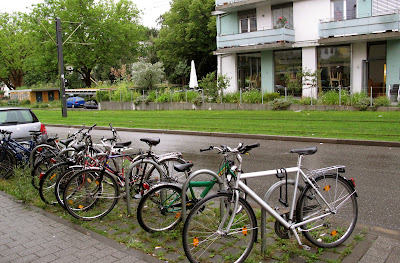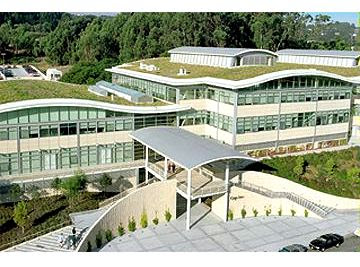While killing some time in a local bookstore a few days ago, I came upon this book on the 'local interest' table. I flipped through a few pages of Novella Carpenter's Farm City: The Education of an Urban Farmer and quickly decided based on the extremely clear descriptions of how she 'harvested' her first rabbit, that I would never farm anything other than fruits or vegetables. I would however be willing to trade produce with someone that could handle those details for me.
Urban Farming has been on the tip of a lot of people's tongues lately, probably as a side effect to so many people wanting to know where their food comes from and lately it hasn't been isolated to the coasts. Time magazine has published articles here and here and I just noticed a piece in a recent People magazine about a young girl that provides a homeless shelter with produce that she grows in her family's backyard. I know that folks living in Northern California seem to be particularly keen on eating local produce and meats. In 2005 four women from the San Francisco Bay area declared themselves Locavores and "urged people to buy, cook and eat from within ... their own foodshed, based on where they live." This "100-mile diet" challenge was taken by a handful of people around the world that year and has grown every challenge since then. In 2007 the word Locavore was chosen as the word of the year by the Oxford American Dictionary.
While the 100-mile diet isn't for everyone, something most of us can do is to grow some things ourself. Earlier in the year First Lady Michelle Obama had part of the White House lawn turned into a vegetable garden as a way to "teach children better eating habits by helping them understand where food comes from." Suddenly the idea of growing our own food didn't seem quite so crazy after all! If we each dug up a small corner of our yard or planted a pot on our patio to grow one thing, we could be one step closer to knowing where the food we eat comes from.
This summer, one of my neighbors did exactly that. After spending a couple of weekends pulling out a row of unruly juniper bushes they built four raised beds and filled them with soil and seeds. Before long the 'Yarden' across the street was sprouting things all over the place; more than the family that lived there could possibly eat. As a result everyone in the neighborhood has been the recipient of a bag of vegetables at some point since then. They definitely knew what they were doing and planted things that would produce all summer and into the fall. Even today, things are still going strong.
Now I recognize that some of us may have perfect growing spots, but not the know how to cultivate. And that is where organizations like San Francisco based Urban Farmers come in. Their goal is "to help families reduce their carbon footprint, reduce their water use, avoid agricultural chemicals in their food, and enjoy nutritious food that taste good -- one garden at a time." Once contacted, they will come take a look and help you get things set up in a way that is both productive and that looks nice. If all you can do is contribute land, that's fine too. This particular group has connected with a city sustainability organization to pilot a program where they plant 'Yardens' in order to grow fruits and vegetables that in turn can be distributed to the community.
Most of us have a space that we can have a container to put a cherry tomato plant and some basil. Add a little more space and there could be beans, cucumbers and a pepper plant. Those of us that are fortunate enough to have yards can plant a profusion of fruits and vegetables and share the bounty with friends, neighbors or even those that may not have the means or ability to grow their own. We've tried grass lawns and English gardens and rock gardens; why not try yardening and see if we can taste the difference.
Urban Farming has been on the tip of a lot of people's tongues lately, probably as a side effect to so many people wanting to know where their food comes from and lately it hasn't been isolated to the coasts. Time magazine has published articles here and here and I just noticed a piece in a recent People magazine about a young girl that provides a homeless shelter with produce that she grows in her family's backyard. I know that folks living in Northern California seem to be particularly keen on eating local produce and meats. In 2005 four women from the San Francisco Bay area declared themselves Locavores and "urged people to buy, cook and eat from within ... their own foodshed, based on where they live." This "100-mile diet" challenge was taken by a handful of people around the world that year and has grown every challenge since then. In 2007 the word Locavore was chosen as the word of the year by the Oxford American Dictionary.
While the 100-mile diet isn't for everyone, something most of us can do is to grow some things ourself. Earlier in the year First Lady Michelle Obama had part of the White House lawn turned into a vegetable garden as a way to "teach children better eating habits by helping them understand where food comes from." Suddenly the idea of growing our own food didn't seem quite so crazy after all! If we each dug up a small corner of our yard or planted a pot on our patio to grow one thing, we could be one step closer to knowing where the food we eat comes from.
This summer, one of my neighbors did exactly that. After spending a couple of weekends pulling out a row of unruly juniper bushes they built four raised beds and filled them with soil and seeds. Before long the 'Yarden' across the street was sprouting things all over the place; more than the family that lived there could possibly eat. As a result everyone in the neighborhood has been the recipient of a bag of vegetables at some point since then. They definitely knew what they were doing and planted things that would produce all summer and into the fall. Even today, things are still going strong.
Now I recognize that some of us may have perfect growing spots, but not the know how to cultivate. And that is where organizations like San Francisco based Urban Farmers come in. Their goal is "to help families reduce their carbon footprint, reduce their water use, avoid agricultural chemicals in their food, and enjoy nutritious food that taste good -- one garden at a time." Once contacted, they will come take a look and help you get things set up in a way that is both productive and that looks nice. If all you can do is contribute land, that's fine too. This particular group has connected with a city sustainability organization to pilot a program where they plant 'Yardens' in order to grow fruits and vegetables that in turn can be distributed to the community.
Most of us have a space that we can have a container to put a cherry tomato plant and some basil. Add a little more space and there could be beans, cucumbers and a pepper plant. Those of us that are fortunate enough to have yards can plant a profusion of fruits and vegetables and share the bounty with friends, neighbors or even those that may not have the means or ability to grow their own. We've tried grass lawns and English gardens and rock gardens; why not try yardening and see if we can taste the difference.
















